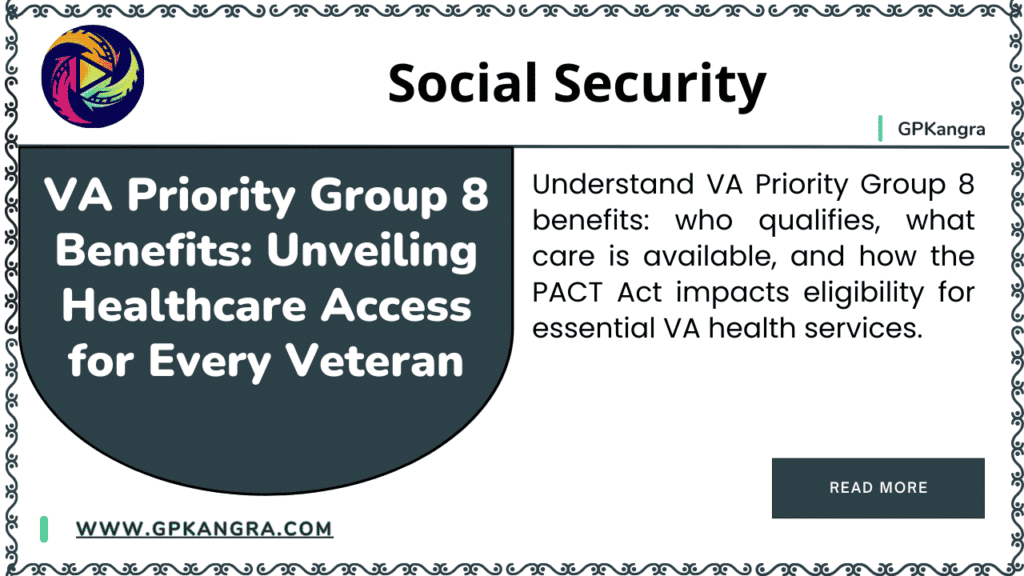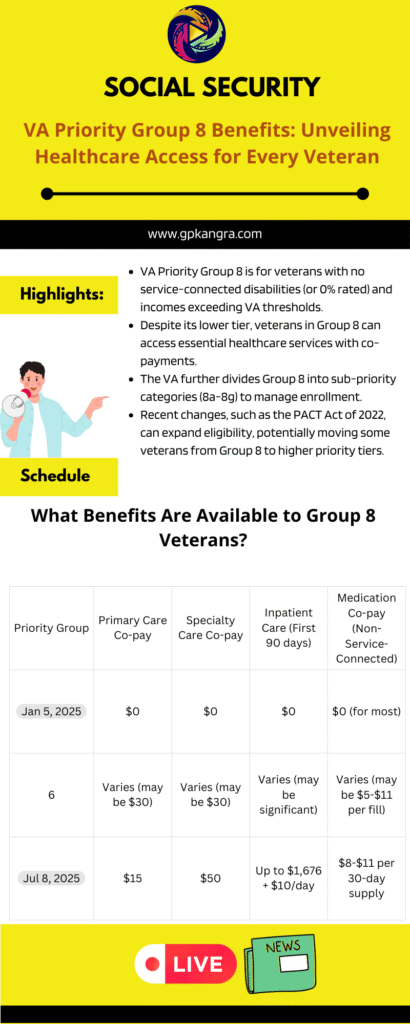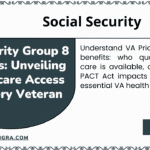Navigating the U.S. Department of Veterans Affairs (VA) healthcare system can be complex, especially when it comes to understanding priority groups. This article sheds light on VA Priority Group 8 benefits, detailing who qualifies, what services are available, and how recent legislative changes like the PACT Act may impact eligibility. Discover how veterans in this category can still access vital healthcare despite being at the lower tier of the VA’s classification system.
Highlights:
- VA Priority Group 8 is for veterans with no service-connected disabilities (or 0% rated) and incomes exceeding VA thresholds.
- Despite its lower tier, veterans in Group 8 can access essential healthcare services with co-payments.
- The VA further divides Group 8 into sub-priority categories (8a-8g) to manage enrollment.
- Recent changes, such as the PACT Act of 2022, can expand eligibility, potentially moving some veterans from Group 8 to higher priority tiers.
Unlocking VA Priority Group 8 Benefits: Your Guide to Essential Healthcare

VA Priority Group 8 Benefits: Unveiling Healthcare Access for Every Veteran
The U.S. Department of Veterans Affairs (VA) plays a crucial role in providing healthcare and disability benefits to former service members. To efficiently manage the allocation of these vital resources, the VA employs a comprehensive system of priority groups.
These groups determine a veteran’s access to healthcare, the speed of their enrollment, and the potential costs involved. While higher priority groups typically offer more extensive benefits with fewer out-of-pocket expenses, it’s essential for all veterans to understand their classification. This article focuses specifically on VA Priority Group 8 benefits, often referred to as Priority Group C in administrative contexts, and outlines what it means for veterans.
Understanding the VA Priority Group System
The VA’s priority group system is designed to ensure that veterans with the greatest needs—such as those with severe service-connected disabilities—receive care first. This tiered structure is based on several factors, including:
- Service-connected disabilities: The severity and rating of disabilities incurred or exacerbated during military service.
- Income level: A veteran’s household income and net worth relative to VA financial thresholds.
- Military service history: Specific periods of service, combat exposure, or unique circumstances.
- Other factors: Such as Medal of Honor recipients, former Prisoners of War (POWs), or those eligible for Medicaid.
At the lowest tier of this structure is VA Priority Group 8, which includes a specific group of veterans who may not meet the more generous eligibility requirements of the higher categories but are still entitled to certain VA benefits.
While veterans in Group 8 face limitations compared to those in higher groups, they may still be able to receive essential VA health care services under specific conditions. This classification helps the VA manage demand while continuing to provide support to eligible veterans with limited entitlement.
Who Qualifies for VA Priority Group 8 (Group C)?
Veterans assigned to VA Priority Group 8 are generally those who do not have a high enough disability rating or whose income and net worth exceed the VA’s financial eligibility thresholds. Specifically, veterans in this group typically fit the following criteria:
- They have no service-connected disabilities, or their disabilities are rated at 0% by the VA.
- Their incomes or net worth exceed the VA’s financial eligibility thresholds.
- They did not enroll in VA health care before January 16, 2003.
- They do not meet the low-income or hardship criteria required for Groups 5 or 7.
- Concrete Mix Design calculator as per IS 10262 : 2019
- ITR Filing Last Date 2025: New Deadlines Announced!
- AP EAMCET Seat Allotment 2025: Your College Awaits!
It’s important to note that this classification is often referred to as Priority Group C in administrative contexts, where letters are sometimes used interchangeably with numbers.
Sub-Priority Categories within Group 8
To better manage enrollment and clarify eligibility, the VA further breaks down VA Priority Group 8 into sub-priority categories (8a through 8g). These subgroups are crucial for determining who may be eligible for enrollment:
- Sub-priority 8a and 8b: These include veterans who were already enrolled in VA health care before January 16, 2003, and who have no service-connected disabilities or are rated at 0 percent. These individuals remain eligible under “grandfathered” rules, ensuring their continued access to care.
- Sub-priority 8e through 8g: These categories apply to veterans who applied for enrollment after the January 2003 cutoff date and do not meet any special exceptions. Unfortunately, many applicants in these categories may be denied enrollment if they exceed income thresholds or lack service-connected status.

Exceptions and Special Considerations
Despite the general restrictions for VA Priority Group 8 benefits, there are several important exceptions:
- Combat Zone Service: Veterans who served in a combat zone after November 11, 1998, and were discharged on or after January 28, 2003, may temporarily qualify for a higher group (typically Group 6) for a period of five years after their separation from service. Once this period ends, they may be moved to VA Priority Group 8 depending on their current eligibility standards, including disability ratings and income.
- The PACT Act of 2022: This landmark legislation has significantly expanded eligibility for many veterans, particularly those exposed to toxic substances during their service. The PACT Act created presumptive conditions for various illnesses, meaning that veterans with qualifying service and diagnoses are presumed to have a service-connected condition without having to prove a direct link.
- This can be a game-changer for veterans in VA Priority Group 8, potentially allowing them to move into higher-priority categories if they qualify under the new guidelines. For example, a veteran with a previously non-service-connected illness now recognized as presumptive under the PACT Act could see their disability rating change, thus impacting their priority group.
What Benefits Are Available to Group 8 Veterans?
While veterans in VA Priority Group 8 generally pay co-payments for most services and are not eligible for certain benefits like travel reimbursements, long-term care, or routine dental services (unless they qualify under separate eligibility standards, such as recent combat service or catastrophic disability), they still have access to a range of essential VA health care services.
Here’s a breakdown of the core VA Priority Group 8 benefits:
- Primary Care and Specialty Appointments: Access to general medical care and referrals to specialists as needed.
- Mental Health Support: Counseling, therapy, and other mental health services are available.
- Prescription Medications: Medications are provided, though typically with required co-pays for non-service-connected conditions.
- Preventive Services and Screenings: Important health screenings and preventive care to maintain overall well-being.
- Access to VA Medical Centers and Community Providers: Care is available both within VA facilities and through authorized community providers when VA services are not readily accessible.
Here’s a simplified table illustrating the general differences in co-payments for various priority groups:
| Priority Group | Primary Care Co-pay | Specialty Care Co-pay | Inpatient Care (First 90 days) | Medication Co-pay (Non-Service-Connected) |
| 1-5 | $0 | $0 | $0 | $0 (for most) |
| 6 | Varies (may be $30) | Varies (may be $30) | Varies (may be significant) | Varies (may be $5-$11 per fill) |
| 7-8 | $15 | $50 | Up to $1,676 + $10/day | $8-$11 per 30-day supply |
Note: Co-payment rates are subject to change by the VA and may vary based on specific services and individual financial assessments.
What if I was Previously Denied Enrollment?
Veterans who were previously denied enrollment under VA Priority Group 8 criteria should absolutely consider reapplying if their circumstances have changed. A shift in any of the qualifying factors could alter their eligibility and potentially move them into a higher, more beneficial priority group. Such changes might include:
- A drop in income or net worth: If your financial situation has changed, you might now fall below the VA’s income thresholds, qualifying you for a higher group.
- Development of a service-connected condition: If you develop a health condition that is later determined to be service-connected, or an existing condition receives a higher disability rating, your priority group could improve significantly.
- New legislative provisions: As highlighted by the PACT Act, new laws can expand eligibility criteria, making previously ineligible veterans now qualify for enhanced benefits. It is highly recommended for veterans who served in areas of toxic exposure to check their eligibility under the PACT Act, even if they were previously denied.
Reapplying is a straightforward process, and VA representatives or accredited Veterans Service Organizations (VSOs) can provide assistance. It’s crucial to stay informed about changes in VA policy and legislation, as they can directly impact your access to the healthcare and benefits you’ve earned.
Conclusion
While VA Priority Group 8 benefits come with certain limitations and co-payment requirements, they still provide essential healthcare services to a significant number of veterans. Understanding the criteria for this group, its sub-categories, and crucially, how recent legislative changes like the PACT Act can impact your status, is vital.
Veterans are encouraged to regularly review their eligibility and reapply if their circumstances change. The VA’s commitment is to serve all who have served our nation, and by staying informed, you can ensure you receive the healthcare benefits you deserve.
FAQs about VA Priority Group 8 Benefits
1. What does it mean to be in VA Priority Group 8?
Being in VA Priority Group 8 means you are a veteran who typically has no service-connected disabilities (or a 0% rating) and whose income or net worth exceeds the VA’s established financial thresholds. You will generally pay co-payments for most VA healthcare services.
2. Can veterans in VA Priority Group 8 receive free healthcare?
Generally, veterans in VA Priority Group 8 are required to pay co-payments for most services, including primary care, specialty care, inpatient stays, and prescription medications for non-service-connected conditions. Free healthcare is typically reserved for veterans in higher priority groups with more significant service-connected disabilities or lower incomes.
3. How does the PACT Act affect VA Priority Group 8 benefits?
The PACT Act of 2022 has significantly expanded eligibility for veterans exposed to toxic substances. If a veteran in VA Priority Group 8 served in a covered location or during a covered time frame and is diagnosed with a presumptive condition under the PACT Act, they may become eligible for a service-connected disability rating, which could move them into a higher VA priority group with more comprehensive benefits and reduced or no co-payments.
4. What kind of healthcare services are available for VA Priority Group 8 veterans?
Despite co-pays, veterans in VA Priority Group 8 can access essential services such as primary care, specialty appointments, mental health support, prescription medications, preventive services and screenings, and care at VA medical centers and authorized community providers.
5. I was previously denied for VA healthcare. Should I reapply for VA Priority Group 8 benefits?
Yes, if your circumstances have changed (e.g., a drop in income, development of a service-connected condition, or changes in VA legislation like the PACT Act), you should consider reapplying. Your eligibility may have improved, potentially allowing you to enroll or qualify for a higher priority group.
Also read :
- Concrete Mix Design calculator as per IS 10262 : 2019
- ITR Filing Last Date 2025: New Deadlines Announced!

- AP EAMCET Seat Allotment 2025: Your College Awaits!

- UGC NET CUTOFF MARKS 2025 : SUBJECT / CATEGORY WISE CUTOFF MARKS

- Age 62 vs. 70: The Social Security Quick Calculator Reveals Your Perfect Retirement Sweet Spot!

Disclaimer : We gather our information from official websites and aim for accuracy and timeliness. However, some details may need further clarification or updates. Please contact us via our Contact Page with any questions or feedback, as your input helps us maintain accuracy. For the latest information, always refer to official sources.
Thank you for your understanding.
Team GPK News








